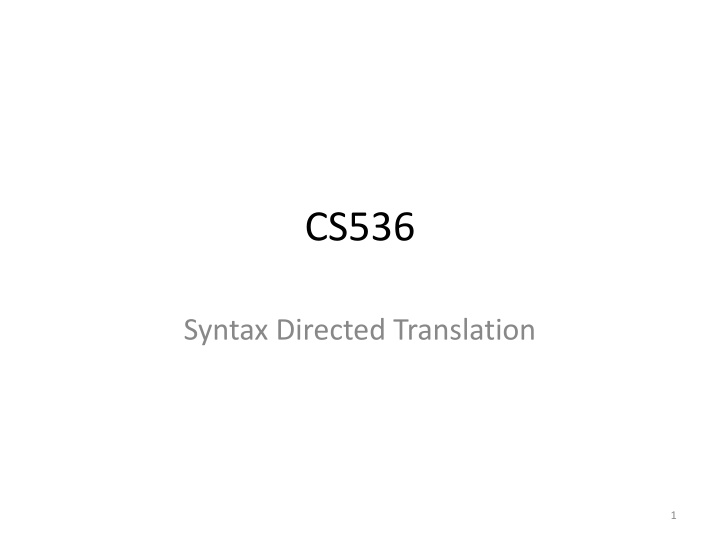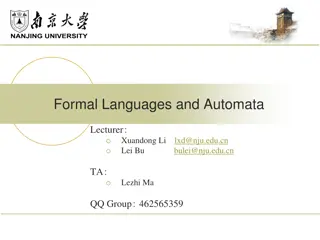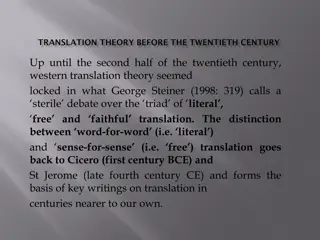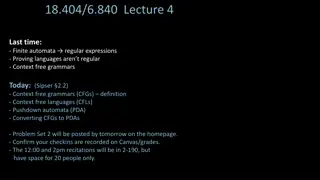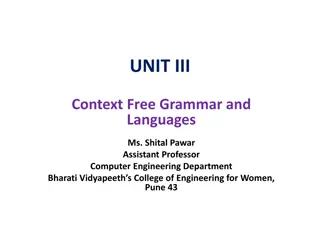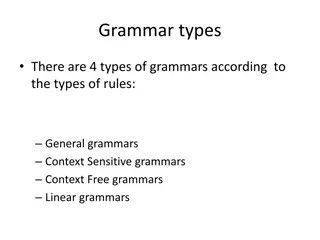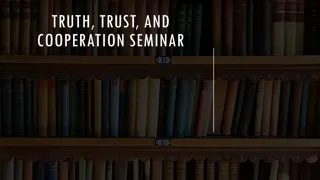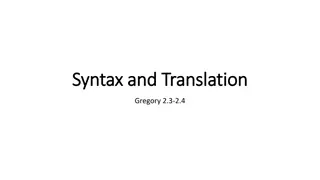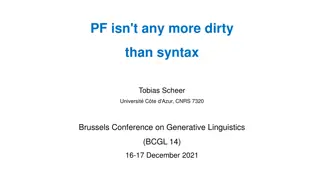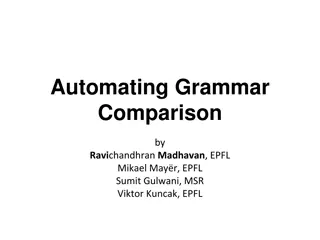Syntax-Directed Translation in Context-Free Grammars: Understanding CFGs and Language Recognition
This content delves into Syntax-Directed Translation in the realm of Context-Free Grammars (CFGs). It explores the augmentation of CFG rules with translation rules for language recognition, emphasizing the transformation of strings into parse trees. Through examples like binary numbers and declarations, the process of translating sequences of tokens into actions is elucidated. The augmentation of grammar to output only integer declarations is also demonstrated, showcasing the versatility and applicability of Syntax-Directed Translation in defining and recognizing languages.
Download Presentation

Please find below an Image/Link to download the presentation.
The content on the website is provided AS IS for your information and personal use only. It may not be sold, licensed, or shared on other websites without obtaining consent from the author.If you encounter any issues during the download, it is possible that the publisher has removed the file from their server.
You are allowed to download the files provided on this website for personal or commercial use, subject to the condition that they are used lawfully. All files are the property of their respective owners.
The content on the website is provided AS IS for your information and personal use only. It may not be sold, licensed, or shared on other websites without obtaining consent from the author.
E N D
Presentation Transcript
CS536 Syntax Directed Translation 1
CFGs so Far CFGs for Language Definition The CFGs we ve discussed can generate/define languages of valid strings So far, we start by building a parse tree and end with some valid string CFGs for Language Recognition Start with a string and end with a parse tree for it 2
CFGs for Parsing Language Recognition isn t enough for a parser We also want to translate the sequence Parsing is a special case of Syntax-Directed Translation Translate a sequence of tokens into a sequence of actions 3
Syntax Directed Translation Augment CFG rules with translation rules (at least 1 per production) Define translation of LHS nonterminal as a function of Constants RHS nonterminal translations RHS terminal value Assign rules bottom up 4
SDT Example: Binary Numbers CFG B -> 0 | 1 | B0 | B1 Rules B.trans = 0 B.trans = 1 B.trans = B2.trans * 2 B.trans = B2.trans * 2 + 1 Input string 10110 22 B 11 B 0 5 B 1 Translation is the value of the input 2 B 1 1 B 0 1 5
SDT Example 2: Declarations Translation is a String of ids CFG DList Decl Type Rules DList.trans = DList.trans=Decl.trans+ + DList2.trans Decl.trans = id.value | DListDecl Typeid; int | bool xx yy DList Input string int xx; bool yy; xx yy DList Decl Type id xx DList Decl bool Type id int 6
Exercise Time Only add declarations of type int to the output String. Augment the previous grammar: CFG DList Decl Type Rules DList.trans = DList.trans=Decl.trans+ + DList2.trans Decl.trans = id.value | DeclDList Typeid; int | bool Different nonterms can have different types Rules can have conditionals 7
SDT Example 2b: ints only Translation is a String of int ids only CFG DList Decl Type Rules DList.trans = DList.trans=Decl.trans+ + DList2.trans if (type.trans){Decl.trans = id.value} else {Decl.trans = } Type.trans = true Type.trans = false xx | DeclDList Typeid; int | bool DList Input string int xx; bool yy; xx DList Decl false Type id xx Different nonterms can have different types DList Decl bool true Type id Rules can have conditionals int 8
SDT for Parsing In the previous examples, the SDT process assigned different types to the translation: Example 1: tokenized stream to an integer value Example 2: tokenized stream to a (java) String For parsing, we ll go from tokens to an Abstract-Syntax Tree (AST) 9
Abstract Syntax Trees Parse Tree A condensed form of the parse tree Operators at internal nodes (not leaves) Chains of productions are collapsed Syntactic details omitted Expr mult Term int (8) Factor Term * intlit (8) Factor ( Expr ) add Example: (5+2)*8 Expr + Term mult int (2) Term add Factor int (8) int (5) Factor intlit (2) int (5) int (2) intlit (5) 10
Exercise #2 Expr -> Expr + Term | Term Term -> Term * Factor | Factor Factor -> intlit | ( Expr ) Show the AST for: (1 + 2) * (3 + 4) * 5 + 6 11
AST for Parsing In previous slides we did our translation in two steps Structure the stream of tokens into a parse tree Use the parse tree to build an abstract syntax tree, throw away the parse tree In practice, we will combine these into 1 step Question: Why do we even need an AST? More of a logical view of the program Generally easier to work with 12
AST Implementation How do we actually represent an AST in code? We ll take inspiration from how we represented tokens in JLex 13
ASTs in Code Note that we ve assumed a field-like structure in our SDT actions: DList.trans=Decl.trans + + DList2.trans In our parser, we ll define classes for each type of nonterminal, and create a new nonterminal in each rule. In the above rule we might define DList to be represented as public class DList{ public String trans; } For ASTs: when we execute an SDT rule, we construct a new node object for the RHS, and propagate its fields with the fields of the LHS nodes 14
Thinking about implementing ASTs Consider the AST for a simple language of Expressions Input 1 + 2 Tokenization intlit plus intlit Na ve AST Implementation AST class PlusNode IntNode left; IntNode right; } + Parse Tree 1 2 Expr class IntNode{ int value; } Expr plus Term Term Factor Factor intlit 2 intlit 1 15
Thinking about implementing ASTs Consider AST node classes We d like the classes to have a common inheritance tree Na ve AST Implementation Na ve java AST AST class PlusNode { IntNode left; IntNode right; } + PlusNode IntNode left: IntNode right: 1 2 class IntNode { } IntNode int value: IntNode int value: int value; 1 2 16
Thinking about implementing ASTs Consider AST node classes We d like the classes to have a common inheritance tree Na ve AST Implementation Better java AST AST class PlusNode { IntNode left; IntNode right; } + PlusNode ExpNode left: ExpNode right: 1 2 class IntNode { } IntNode int value: IntNode int value: int value; 2 1 Make these extend ExpNode 17
Implementing ASTs for Expressions CFG Expr -> Expr + Term | Term Term -> Term * Factor | Factor Factor -> intlit | ( Expr ) Translation Rules Expr1.trans = new PlusNode(Expr2.trans, Term.trans) Expr.terms = Term.trans Term1.trans = new TimesNode(Term2.trans, Factor.trans) Term.trans = Factor.trans Factor.trans = new IntNode(intlit.value) Factor.trans = Expr.trans Example: 1 + 2 Expr PlusNode ExpNode left: ExpNode right: Expr plus Term Term Factor Factor intlit 2 IntNode value: IntNode value: 2 1 intlit 1 18
An AST for a C Flat Snippet void foo(int x, int y){ if (x == y){ return; } while ( x < y){ cout << hello ; x = x + 1; } } FuncBody while if return == return < print = x y x y x + hello x 1 19
Summary (1 of 2) Today we learned about Syntax-Directed Translation (SDT) Consumes a parse tree with actions Actions yield some result Abstract Syntax Trees (ASTs) The result of SDT for parsing in a compiler Some practical examples of ASTs 20
Summary (2 of 2) Language abstraction: RegEx Output: Token Stream Tool: JLex Implementation: DFA walking via table Scanner Language abstraction: CFG Output: AST by way of Parse Tree Tool: Java CUP Implementation: ??? Parser Next time Next week 21
